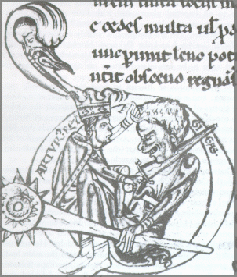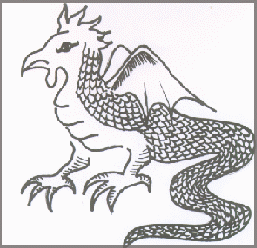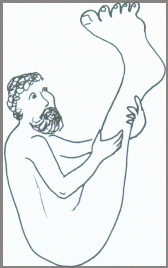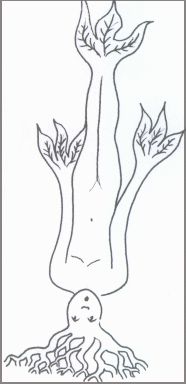
Here are some of them...
 There were plenty of giants in stories told in the Middle Ages. This is King Arthur fighting the Giant of the Mont St Michel in Normandy.
There were plenty of giants in stories told in the Middle Ages. This is King Arthur fighting the Giant of the Mont St Michel in Normandy.
 There
were other monsters too, such as the Basilisk (right), an evil creature, half-cockerel
and half-snake. It slithered along the ground but held up its cockerel's head
to fix people with its burning eyes, which could hypnotise the monster's victims
so they could not move. Wherever its slimy tail dragged on the ground the plants
withered and died and the earth cracked. The Basilisk's breath could poison
water. According to one story, when Saint Patrick met a Basilisk, he killed
it by holding up his shining shield, so that the monster saw its own reflection
and gazed into its own terrible eyes.
There
were other monsters too, such as the Basilisk (right), an evil creature, half-cockerel
and half-snake. It slithered along the ground but held up its cockerel's head
to fix people with its burning eyes, which could hypnotise the monster's victims
so they could not move. Wherever its slimy tail dragged on the ground the plants
withered and died and the earth cracked. The Basilisk's breath could poison
water. According to one story, when Saint Patrick met a Basilisk, he killed
it by holding up his shining shield, so that the monster saw its own reflection
and gazed into its own terrible eyes.

 Early
explorers brought back tales of strange races of people living in distant parts
of the earth. Some,
like the pygmies, really did exist, but others, like the Dog-faced man (left)
have never been found since.
Early
explorers brought back tales of strange races of people living in distant parts
of the earth. Some,
like the pygmies, really did exist, but others, like the Dog-faced man (left)
have never been found since.
Medieval maps showed some of these people, and where they were believed to live. The 13th Century Map of the World (Mappa Mundi) in Hereford Cathedral shows a Sciapod (right) from the East of India, who uses his one enormous foot to shelter himself from the hot sun.

 There
is the Mandrake (left), half man and half plant, growing on the banks of
the River Nile in Egypt. The Mandrake was believed to scream when pulled from
the ground and to be able to cure people who could not have children.
There
is the Mandrake (left), half man and half plant, growing on the banks of
the River Nile in Egypt. The Mandrake was believed to scream when pulled from
the ground and to be able to cure people who could not have children.
A Hermaphrodite was a creature thought to be half-man, half-woman. There were the Anthropophagi (right), people whose heads grew below their shoulders and the Gangines who lived by breathing the scent of apples. Their digestion was so delicate that this was their only food. The position of the countries shown on the map is quite different than we know them today. This is because the map-makers believed that Jerusalem had to be at the centre of the world, since it was the holiest city on earth.